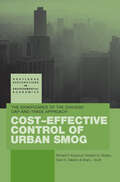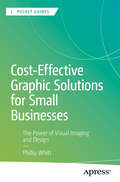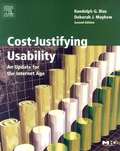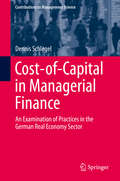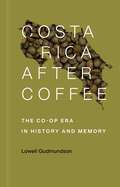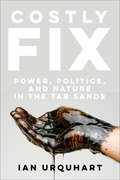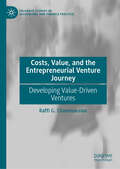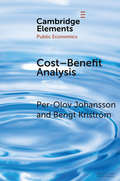- Table View
- List View
Cost-Conscious Marketing Research
by Alan R. AndreasenMany small businesses and nonprofit organizations avoid doing marketing research because they have at least five misconceptions about it: the big decision myth; the survey myopia myth; the big bucks myth; the sophisticated researcher myth; and the most research is not read myth.
Cost-Effective Control of Urban Smog: The Significance of the Chicago Cap-and-Trade Approach (Routledge Explorations in Environmental Economics)
by Richard Kosobud Houston Stokes Carol Tallarico Brian ScottContaining rigorous hard evidence, this book is of immense practical use to postgraduates, researchers and business communities affected by or working in environmental regulation. The author, a leading name in the environmental economics community, examines the problem of urban smog in cityscapes and the difficulty of achieving cost-effective controls. Analyzing the key areas of urban smog, low-level ozone and volatile organic compound emissions and their impact on health and welfare of communities this text assesses and evaluates the performance of emissions trading systems and suggests alternative market designs for incentive control of pollution. Taking a well-reasoned approach to the contentious area of the use of market incentives to achieve environmental goals, it provides a study of the pioneering cap-and-trade market, particularly focusing on its poor performance in Chicago. A perfect supplementary text postgraduates and researchers, this is also an essential read for all those interested in environmental economics.
Cost-Effective Graphic Solutions for Small Businesses: The Power of Visual Imaging and Design (Apress Pocket Guides)
by Phillip WhittDelve into learning the strategies for producing impressive graphics without overspending. This all-inclusive manual equips small business proprietors with the knowledge and skills to utilize open source tools, graphics and photo libraries and how to put them to good use. Learn how to tap into a vast collection of premium stock photos from Pexels and Pixabay to elevate your visual content. Additionally, delve into the innovative capabilities of AI technology, transforming the process of graphic design and production. Whether you are an experienced entrepreneur or a novice in the field, this guide serves as your pathway to visually appealing and cost-effective marketing materials. Cost-Effective Image and Graphic Solutions for Small Businesses is your guide to creating impressive and effective graphics that won’t strain your budget. Discover powerful no-cost image editing programs such as Paint.NET, GIMP, and FotoSketcher to incorporate into your visual designs as well as affordable web-based solutions for creating marketing materials such as business cards, posters, flyers, social media posts, and more. There are even tips for saving on large-format visuals, and graphics for company vehicles. You Will Learn To: Enhance your professional visual identity for your business Utilize programs such as Paint.NET to touch up photos, and create business cards, flyers, and other graphic materials Use GIMP as an alternative to Adobe Photoshop for photo editing and raster illustrations Turn photographic images into art with the easy-to-use FotoSketcher Make scalable vector graphics using Inkscape Navigate royalty free stock photo libraries and archives available for both personal and commercial use Explore web-based solutions for creating professional-looking marketing materials such as business cards, postcards, flyers, and social media posts Utilise AI to generate compelling images, idea and content Who is This For: This book is for any small business owner, manager or graphics designer requiring the means to create quality graphics and visuals on a tight budget
Cost-Engineering-System in den produzierenden Unternehmen: Methoden, Prozesse und Erfahrungsberichte aus der Praxis
by Xiaoyi LiuFunktion, Qualität und Kosten sind die drei Kernelemente eines Produkts. Vor allem in der Zukunft, unter dem allgemeinen Trend der Digitalisierung und AI, ist es für produzierende Unternehmen ein Muss, ein vollständiges Cost-Engineering-System zu etablieren.Basierend auf 25 Jahren praktischer Erfahrung und Methodenforschung in deutschen und chinesischen Automobilunternehmen stellt der Autor in diesem Buch zum ersten Mal Cost- Engineering-System, Cost-Engineering-Methoden und deren praktische Anwendungen im gesamten Produktprozess systematisch vor, und präsentiert eine große Anzahl von Beispielen der Kostenoptimierung aus Praxis. Blickt man in die Zukunft, wie der Qualitätssystemstandard benötigt auch das Cost-Engineering- System einen Standard für Produktionsunternehmen. Kostenanalysesoftware, AI + Cost Engineering sind wichtige Mitteln für produzierende Unternehmen, um das Potenzial der Kostenoptimierung im vollen Umfang und in intelligenter Weise auszuschöpfen.
Cost-Justifying Usability: An Update for an Internet Age
by Randolph G. Bias Deborah J. MayhewYou just know that an improvement of the user interface will reap rewards, but how do you justify the expense and the labor and the time-guarantee a robust ROI!-ahead of time? How do you decide how much of an investment should be funded? And what is the best way to sell usability to others? In this completely revised and new edition, Randolph G. Bias (University of Texas at Austin, with 25 years' experience as a usability practitioner and manager) and Deborah J. Mayhew (internationally recognized usability consultant and author of two other seminal books including The Usability Engineering Lifecycle) tackle these and many other problems. It has been updated to cover cost-justifying usability for Web sites and intranets, for the complex applications we have today, and for a host of products-offering techniques, examples, and cases that are unavailable elsewhere. No matter what type of product you build, whether or not you are a cost-benefit expert or a born salesperson, this book has the tools that will enable you to cost-justify the appropriate usability investment. 66
Cost-benefit Analysis: With Reference to Environment and Ecology
by James H. Meisel K. PuttaswamaiahThe world is increasingly concerned with bridging the developmental gap between the developed and developing countries. With the establishment of a number of institutions for funding the projects including the World Bank, Asian Development Bank, and many other agencies, the need to develop mechanisms to assess economically viable projects is more important than ever. The Social-Cost Benefit Analysis (SCBA) is an important technique used in formulating, appraising, and evaluating projects. It is a facet of applied welfare economics which is increasingly being used to identify and assess public projects in both developing and developed countries. This volume presents a comprehensive view of cost-benefit analysis in its theoretical and applied dimensions. Both theory and case studies are presented. The theoretical setting for Cost-Benefit Analysis is established by the first five chapters-"Spatial General Equilibrium and Cost-Benefit Analysis," by David M. Newbery; "Optimum Growth Theory and Social Time Preference: A Computerized Mathematical Modeling Exercise to Choose a Social Discount Rate," by Sardar M. N. Islam; "A Theoretical Inquiry of the Axiomatic Consistency of Distributional Weights used in Cost-Benefit Analysis," by Giuseppe Munda; "The Output Gap: Measurement, Related Concepts, and Policy Implications," by Parameswar Nandakumar; and "A Methodological Comparison of Theoretical Approaches in Dichotomous Choice Contingent Valuation," by John C. Whitehead. This book will be useful as a reference text by professors and students in project appraisal classes and will be of equal value to analysts, planners, and interested general readers.
Cost-of-Capital in Managerial Finance: An Examination of Practices in the German Real Economy Sector (Contributions to Management Science)
by Dennis SchlegelThis book examines cost-of-capital models and their application in the context of managerial finance. This includes the use of hurdle rates in capital allocation decisions, as well as target returns in performance management. Besides a review of classical finance models such as the Capital Asset Pricing Model (CAPM), other contemporary models and techniques to determine the cost-of-capital of business units and private companies are discussed. Based on a mixed methods approach, current cost-of-capital practices and their determinants are empirically analyzed among German companies.
Costa Rica After Coffee: The Co-op Era in History and Memory
by Lowell GudmundsonCosta Rica After Coffee explores the political, social, and economic place occupied by the coffee industry in contemporary Costa Rican history. In this follow-up to the 1986 classic Costa Rica Before Coffee, Lowell Gudmundson delves deeply into archival sources, alongside the individual histories of key coffee-growing families, to explore the development of the co-op movement, the rise of the gourmet coffee market, and the societal transformations Costa Rica has undergone as a result of the coffee industry’s powerful presence in the country.While Costa Rican coffee farmers and co-ops experienced a golden age in the 1970s and 1980s, the emergence and expansion of a gourmet coffee market in the 1990s drastically reduced harvest volumes. Meanwhile, urbanization and improved education among the Costa Rican population threatened the continuance of family coffee farms, because of the lack of both farmland and a successor generation of farmers. As the last few decades have seen a rise in tourism and other industries within the country, agricultural exports like coffee have ceased to occupy the same crucial space in the Costa Rican economy. Gudmundson argues that the fulfillment of promises of reform from the co-op era had the paradoxical effect of challenging the endurance of the coffee industry.
Costa Rica: 2001 Article IV Consultation--Staff Report; Staff Statement; Public Information Notice on the Executive Board Discussion; and Statement by the Executive Director for Costa Rica
by International Monetary FundA report from the International Monetary Fund.
Costa Rica: Selected Issues (Imf Staff Country Reports)
by International Monetary Fund. Western Hemisphere Dept.A report from the International Monetary Fund.
Costco Companies, Inc.
by David E. Bell Ann LeamonCostco Companies, one of the major players in the wholesale club industry, has developed a new class of membership that offers discounted services--auto, health, and home insurance, business credit card processing, real estate services--in exchange for a higher annual fee ($100 vs. $40). The case poses two questions: 1) how should the new membership be marketed, to whom, and how much should be spent on the effort? and 2) what are the potential risks and benefits for Costco, which generated $22 billion in 1997 selling products in bulk, in offering services? Which question is emphasized depends on whether the case is taught in a marketing or a retailing course.
Costing Alternative Choices
by Jacob Cohen David F. HawkinsDiscusses the role of differential cost and revenues in solving alternative choice problems.
Costly Bargain of Trade Promotion
by John A. Quelch Walter J. Salmon Robert D. BuzzellOver the last decade, power in the retailing of packaged goods has shifted from manufacturers to wholesalers and sellers. One result has been an increase in consumer and trade promotion. But many trade promotion practices are costly to manufacturers, retailers, and eventually consumers. The authors single out forward buying in the grocery trade and offer evidence of the costs of this practice to the distribution system as a whole. They suggest a policy called "everyday low purchase price", designed to smooth the peaks and valleys of demand and reduce the costs of distribution.
Costly Fix: Power, Politics, And Nature In The Tar Sands
by Ian UrquhartCostly Fix examines the post-1995 Alberta tar sands boom, detailing how the state inflated the profitability of the tar sands and turned a blind eye to environmental issues. It considers the position of First Nations, the character and strength of environmental critiques, and the difficulties that environmental groups and First Nations have had in establishing a countermovement to market fundamentalism. The final chapter discusses how Alberta's new NDP government, in its first couple of years, has addressed the legacies they have inherited from the previous Progressive Conservative government on climate change, royalties, and the blight of tailings ponds in the boreal forest. Throughout the book, Urquhart demonstrates that too many actors have done too little to prevent Alberta's boreal forest from becoming a landscape sacrificed for unsustainable economic growth.
Costovation: Innovation That Gives Your Customers Exactly What They Want--And Nothing More
by Stephen Wunker Jennifer Luo LawWow your customers . . . with "less." Cut costs-it's a common corporate refrain. But if you constantly slash expenditures, what happens to innovation? How can you stay competitive and satisfy customers? Costovation solves the dilemma of how to spend less and innovate more. The book's revolutionary approach broadens the definition of innovation beyond products to the business model itself. With costovation, you let go of assumptions, take a fresh look at the market, and relentlessly focus on what customers really want. Consider Planet Fitness-it grew to 7.3 million members by concentrating on casual exercisers. Those folks don't care about frills. They want easy, low-cost access to good equipment. Although it's inexpensive to run, Planet Fitness ranks highest in gym satisfaction. Gourmet grocer, Picard, sells only frozen food. With less perishable inventory, they compress costs while delighting a discerning but busy clientele. Packed with examples and interactive exercises, the book explores cost innovation strategies that work for big and small companies alike. From open innovation and cost-sharing to simplifying products and turning waste into new offerings-readers learn how rivals are carving out niches, protecting positions, and dominating industries. Innovation and cost-cutting are not opposites. Combined, they expose untapped opportunities to outsmart and underspend competitors.
Costs and Benefits: Why We Need to Study Bad Leadership
by Barbara KellermanMost books that examine leadership do so from the perspective that true leaders are good and ethical leaders, with little or no attention paid to bad leaders. With the costs of bad leadership being so high, ignoring its existence, and allowing it to continue, is a disservice to everyone involved. And focusing on leaders and shortchanging the role of followers, when the two should be looked at in tandem, only makes matters worse.
Costs and Expenses - No Hard-and-Fast Rules: Financial Intelligence for Entrepreneurs
by Karen Berman Joe KnightMost entrepreneurs watch expenses closely. But did you know that there are plenty of estimates and biases that go into those expense lines? This chapter examines the major line items in this section of the income statement - including cost of goods sold, operating expenses, and one-time charges, among others. This chapter is excerpted from "Financial Intelligence for Entrepreneurs."
Costs and Expenses: No Hard-and-Fast Rules
by John Case Karen Berman Joe KnightMost managers have plenty of personal experience with expenses. But did you know that there are plenty of estimates and biases that go into those expense lines? This chapter examines the major line items in this section of the income statement.
Costs and ROI: Evaluating at the Ultimate Level (Measurement and Evaluation Series #5)
by Jack J. Phillips Lizette ZunigaCosts and ROI Costs and ROI is the fifth of six books in the Measurement and Evaluation Series from Pfeiffer. The proven ROI Methodology--developed by the ROI Institute--provides a practical system for evaluation planning, data collection, data analysis, and reporting. All six books in the series offer the latest tools, most current research, and practical advice for measuring ROI in a variety of settings. All costs must be captured for an accurate cost profile. Costs and ROI focuses on developing program costs and the ROI and explains this vital element in the ROI Methodology. The authors show how to capture all costs in order to bring credibility to the analysis. The book outlines the actual ROI calculation and explains the many assumptions and issues that must be considered when calculating the ROI. Costs and ROI presents three effective calculations: the benefit-cost ratio, the ROI percentage, and the payback period. Costs and ROI includes all the challenges and concerns regarding the use of ROI.
Costs, Value, and the Entrepreneurial Venture Journey: Developing Value-Driven Ventures (Palgrave Studies in Accounting and Finance Practice)
by Raffi G. ChammassianIn the fast-paced world of startups and innovation, costs are often treated with passive recognition—overshadowed by strategy, growth, and funding. But what if costs were the key to unlocking sustainable value and driving strategic success? This groundbreaking book redefines the role of costs within the entrepreneurial venture lifecycles, transforming them from passive considerations to active tools for creating, capturing, and extracting value. Through a fresh lens, it explores the inseparable relationship between costs, strategy, and investments—guiding entrepreneurs, founders, and innovation ecosystem players through every stage of the journey, from ideation to successful exit into a reincarnated life. Finally, it establishes a framework for value-driven business models as dynamic, three-dimensional platforms—driven by technology, markets, and exits—where intellectual capital development plays a fundamental role. With practical insights grounded primarily in strategic management accounting and entrepreneurial finance, and supported by real-world applications, this book establishes a powerful foundation for integrating costs into value-driven business strategies. It equips startup founders, innovation ecosystem players, researchers, and academics alike with the tools to rethink costs as a strategic advantage. Whether you're building a startup, thriving in the innovation and knowledge economy, or delving into entrepreneurial finance, this book will transform the way you think about costs—turning them into a powerful catalyst for growth and success.
Costume And Fashion: A Concise History
by James Laver Amy de la HayeThe new fifth edition of this classic guide to clothing throughout history now extends into the second decade of the 21st century. James Laver's classic study of clothing, from the invention of the needle to the dawn of denim, neolithic weavers to catwalk creations, has been updated once again to cover the latest trends, from vintage to high street chic and the spectacular reinvention of haute couture. Featuring designers such as Alexander McQueen and Marc Jacobs, and style leaders Kate Moss and the Duchess of Cambridge, a new final chapter explains the forces shaping fashion today, including Internet technology, celebrity influence, 'fast fashion', the recession and global markets. With eight new pages, six new illustrations and an entirely new final chapter, this book reclaims its position as the definitive concise history of the subject, and remains essential reading for all students of art, costume and fashion.
Costume Design 101: The Business and Art of Creating Costumes for Film and Television
by Richard LaMotteWritten by an industry venteran with 40 years of experience, this book is the new edition of Costume Design
Cost–Benefit Analysis (Elements in Public Economics)
by Per-Olov Johansson Bengt KriströmThis Element on cost-benefit analysis provides a summary of recent theoretical and empirical developments and summarizes state-of-the-art stated-preference and revealed-preference valuation methods. The Element discusses how to assess small (or marginal) as well as large (or non-marginal) projects that have a significant impact on prices and/or other economic variables. It also discusses distortions like taxes, market power, and sticky prices. In addition, risk/uncertainty is considered. A novel feature is the elaboration on flexible evaluation rules for reasonably small projects. Conventional point-estimates of projects should be used with care, because they typically give biased results.
Cotopaxi: Managing Growth for Good
by Laura Huang Andy WuCotopaxi, an innovative outdoor gear business targeting millennials, focuses on profit and social impact. This registered benefit corporation was formed by Davis Smith who coalesced his experiences as a Wharton MBA student along with professional knowledge from an unpaid internship in Peru and his previous e-commerce startups in the US and Brazil. Cotopaxi's social cause is fighting global poverty; their target is to donate 10% of their profits but as a new capital-intensive business they give 2% of their revenue. Their income streams are mainly direct to consumer sales along with corporate sales and a special experience based event-Questival. Their direct to consumer model lowers costs compared to competitors and allows Cotopaxi to offer lower prices, but they face a challenge in positioning their products as high quality.
Cotopaxi: Managing Growth for Good
by Laura Huang Andy WuCotopaxi, an innovative outdoor gear business targeting millennials, focuses on profit and social impact. This registered benefit corporation was formed by Davis Smith who coalesced his experiences as a Wharton MBA student along with professional knowledge from an unpaid internship in Peru and his previous e-commerce startups in the US and Brazil. Cotopaxi's social cause is fighting global poverty; their target is to donate 10% of their profits but as a new capital-intensive business they give 2% of their revenue. Their income streams are mainly direct to consumer sales along with corporate sales and a special experience based event-Questival. Their direct to consumer model lowers costs compared to competitors and allows Cotopaxi to offer lower prices, but they face a challenge in positioning their products as high quality.

